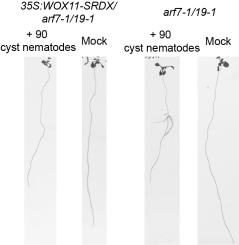
News
Transcription factor WOX11 modulates tolerance to cyst nematodes via adventitious lateral root formation
Plants display intraspecific variation in tolerance limits for root-feeding nematodes. Although disease tolerance has been recognized as a distinct trait in biotic interactions of mainly crops, we lack mechanistic insights. We hypothesize that root architecture plasticity is an important mechanism to mitigate the stress that nematodes inflict on the root system.

The transcription factor WUSCHEL-RELATED HOMEOBOX 11 (WOX11) in Arabidopsis initiates the formation of adventitious lateral roots upon mechanical injury in primary roots. Root-invading nematodes also induce de novo root organogenesis leading to excessive root branching, but it is not known if this symptom of disease involves mediation by WOX11 and if it benefits the plant. In this study, we show with targeted transcriptional repression and reporter gene analyses in Arabidopsis that the beet cyst nematode Heterodera schachtii activates WOX11-adventitious lateral rooting from primary roots close to infection sites. The activation of WOX11 in nematode-infected roots occurs downstream of jasmonic acid-dependent damage signaling via ETHYLENE RESPONSIVE FACTOR109, linking adventitious lateral root formation to nematode damage to host tissues. By measuring different root system components, we found that WOX11-mediated formation of adventitious lateral roots compensates for nematode-induced inhibition of primary root growth. Our observations further demonstrate that WOX11-mediated rooting reduces the impact of nematode infections on aboveground plant development and growth. Altogether, we show that the transcriptional regulation by WOX11 modulates root system plasticity under biotic stress, which is one of the key mechanisms underlying tolerance of Arabidopsis to cyst nematode infections.